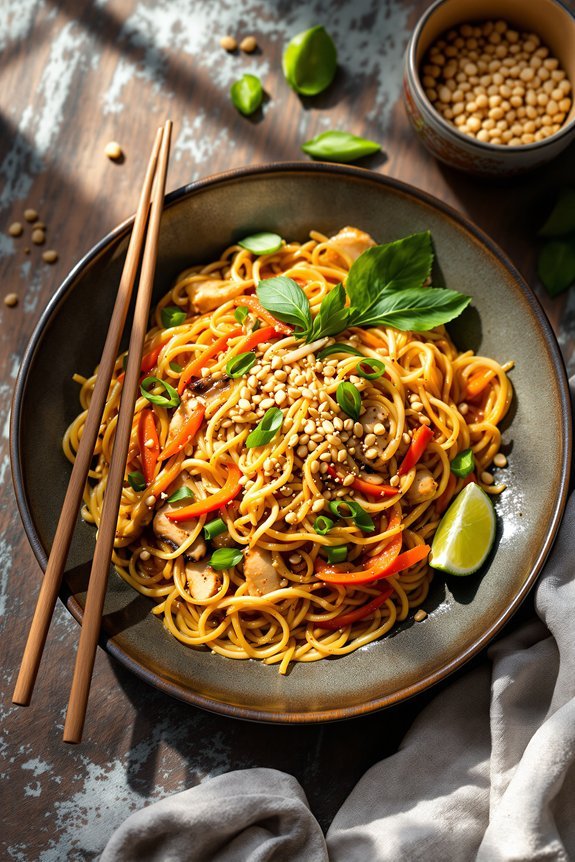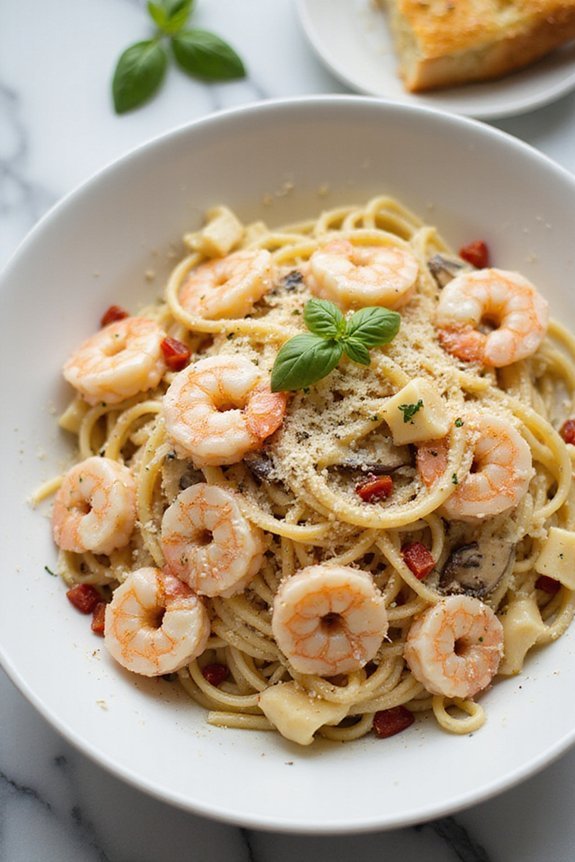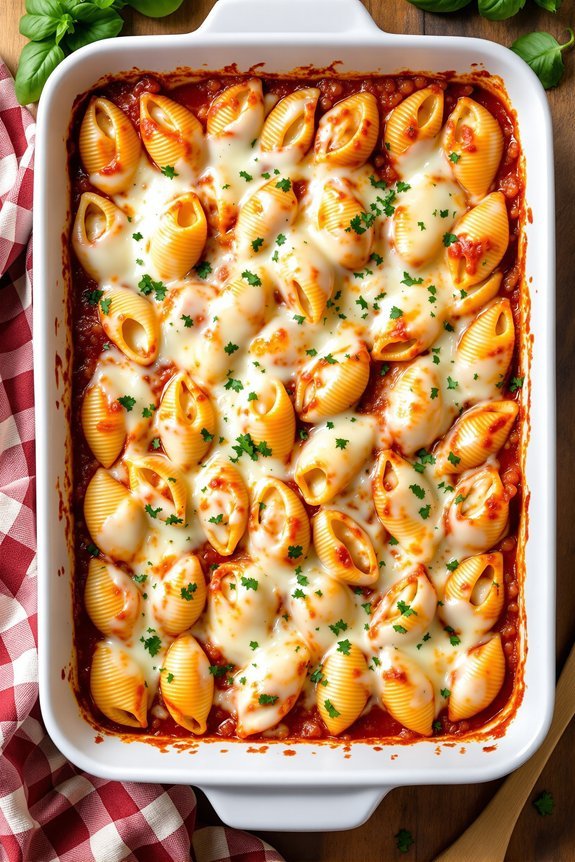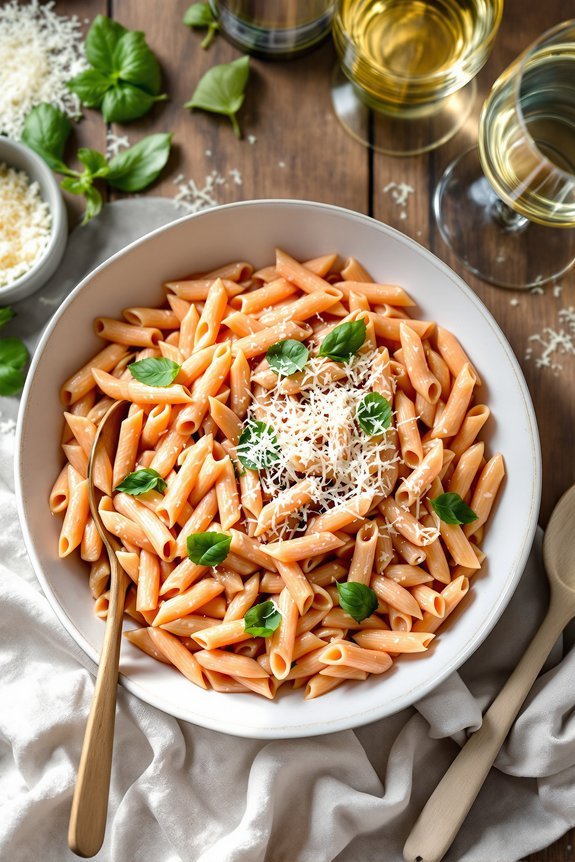Why You’ll Love these Authentic Thai Noodles
Whether you’re a Thai food enthusiast or just looking to spice up your dinner routine, these authentic Thai noodles will quickly become a staple in your recipe collection.
I’m obsessed with how these noodles balance sweet, salty, tangy, and spicy flavors in every bite.
What makes them irresistible? The combination of fish sauce, rice vinegar, and tomato paste creates that signature Thai depth.
The rice noodles soak up all that goodness while staying perfectly chewy.
And those crunchy peanuts against tender chicken and shrimp? Heaven on a plate.
Got dietary restrictions? No problem. This recipe is endlessly adaptable.
What Ingredients are in Authentic Thai Noodles?
Creating authentic Thai noodles at home requires gathering the perfect balance of ingredients that deliver those bold, complex flavors Thai cuisine is known for. What I love about this recipe is how it combines protein, vegetables, and that irresistible sauce that makes pad thai so craveable.
Once you have all these ingredients lined up on your counter, you’re just minutes away from a restaurant-quality meal.
- 8 ounces rice noodles (medium width)
- 6 tablespoons fish sauce
- 1/2 cup rice vinegar (unseasoned)
- 3 tablespoons tomato paste
- 1/2 cup sugar
- 2 eggs
- 2 1/2 tablespoons canola oil
- 5-6 garlic cloves, minced
- 1/4 cup julienned baby carrots
- 4 ounces sliced mushrooms
- 5 green onions, chopped
- 1/2 pound boneless skinless chicken breast, cooked and cut into bite-size pieces
- 1/2 pound shrimp, cooked, peeled and deveined
- 3/4 cup dry-roasted unsalted peanuts, coarsely chopped
- 4 ounces bean sprouts
- 1 lime, cut into wedges
- Crushed red pepper flakes, to taste
When shopping for these ingredients, the fish sauce is non-negotiable, as it provides that distinctive umami flavor that defines Thai cooking.
Can’t find rice noodles? Look in the international aisle of your grocery store, or an Asian market will definitely have them.
And while the recipe calls for both chicken and shrimp, you could easily make this vegetarian by substituting tofu or just loading up on more veggies.
The beauty of Thai noodles is their adaptability to whatever proteins or vegetables you have on hand.
How to Make these Authentic Thai Noodles

Let’s start with the sauce—the heart and soul of any good pad thai. In a bowl, whisk together 6 tablespoons of fish sauce, 1/2 cup of rice vinegar, 3 tablespoons of tomato paste, and 1/2 cup of sugar until everything is well combined. This aromatic mixture mightn’t look like much now, but trust me, it’s going to transform your noodles into something magical. Set this sauce aside while we tackle the other components.
Next, prepare your 8 ounces of rice noodles according to the package directions, but aim for slightly al dente—they’ll continue cooking later in the wok.
While the noodles are soaking, heat up your wok or large skillet and scramble 2 eggs (with a sprinkle of garlic powder if you’re feeling fancy). Once they’re fully cooked, transfer them to a plate.
Now for the fun part: add 2 1/2 tablespoons of canola oil to your hot pan, then toss in those 5-6 minced garlic cloves, 1/4 cup of julienned carrots, and 4 ounces of sliced mushrooms. Stir-fry for about 2-3 minutes until everything becomes fragrant and the vegetables start to soften.
Can you smell that incredible aroma filling your kitchen? That’s the signal to add your prepared sauce to the pan, then introduce your cooked chicken, shrimp, scrambled eggs, and drained noodles. Toss everything together until the noodles have absorbed most of that flavorful sauce.
To finish, fold in your 5 chopped green onions, 3/4 cup of coarsely chopped peanuts, and 4 ounces of bean sprouts. Give everything one final toss until well combined. The texture should be slightly sticky but not swimming in sauce.
Serve immediately on warmed plates, garnished with lime wedges and a sprinkle of crushed red pepper flakes for those who like a bit of heat. I always place extra peanuts and bean sprouts in small bowls on the table—everyone seems to want more of these crunchy toppings to customize their perfect bite.
Authentic Thai Noodles Substitutions and Variations
Three simple substitutions can transform this pad thai recipe to suit any dietary preference or pantry situation.
First, swap the fish sauce with soy sauce or tamari for a vegetarian version—just add a pinch of sugar to balance the flavor.
No rice noodles? Thin spaghetti or even zucchini noodles work in a pinch. Trust me, the sauce carries the dish anyway.
For protein variations, tofu makes a perfect chicken replacement, while mushrooms add that meaty texture without actual meat.
Can’t find bean sprouts? Thinly sliced cabbage provides that essential crunch.
The beauty of pad thai? It’s forgiving, adaptable, and still delicious with whatever you’ve got.
What to Serve with Authentic Thai Noodles
While pad thai shines perfectly as a standalone meal, pairing it with complementary sides elevates your Thai dining experience to restaurant quality.
I love serving crispy spring rolls or fresh summer rolls alongside my noodles—the contrasting textures are divine.
A light cucumber salad with rice vinegar dressing cuts through the richness, while a bowl of tom yum soup makes for a traditional starter.
Want something cooling? Try Thai iced tea.
For a complete spread, add satay skewers with peanut sauce.
The combination of grilled meat and pad thai? Heaven on a plate.
Trust me, your guests will think you’ve opened a Thai restaurant at home.
Final Thoughts
After mastering this authentic pad thai recipe, you’ll never need to order takeout again.
There’s something deeply satisfying about creating this iconic street food in your own kitchen, balancing those perfect sweet, sour, salty, and spicy notes.
I love how versatile pad thai can be—swap proteins, add more veggies, or adjust the heat level to your taste.
The key is prepping all ingredients before you start cooking, as the wok waits for no one.




